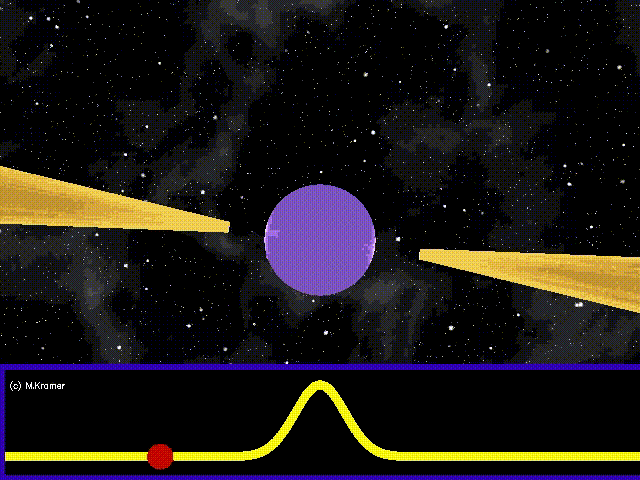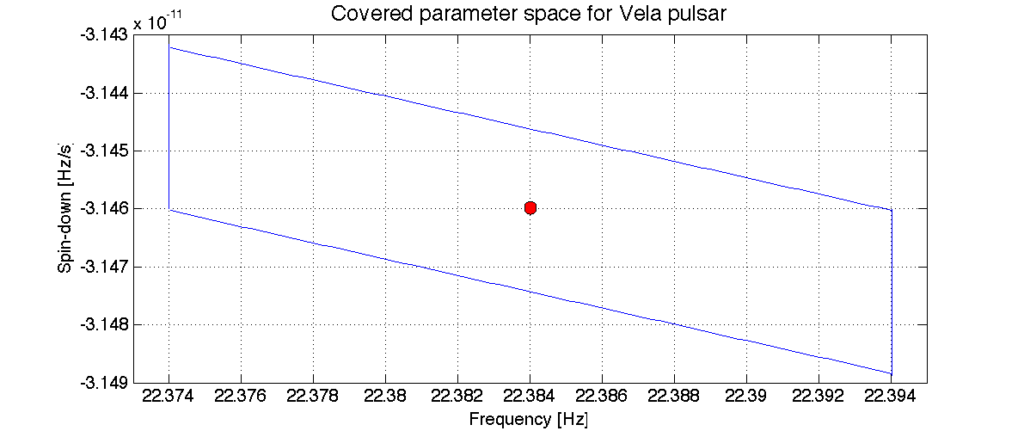Isolated spinning neutron stars are among the targets of interferometric gravitational wave detectors such as Virgo in Italy, LIGO in the US and GEO600 in Germany. If these stars are not perfectly symmetric about their axis of rotation, e.g. if they have a “mountain” on their surface, they are expected to emit continuous gravitational waves. The motion of the gravitational wave detector around the Earth causes a frequency shift of the nearly sinusoidal received signal due to the Doppler effect and a time-depending amplitude variation as the orientation of the gravitational wave observatory with respect to the star changes. Additionally, the emitted signal will slowly decrease in frequency as the star loses energy, not only in the form of gravitational radiation but possibly (and often mainly) also as electromagnetic radiation, an effect called spin-down. Among the roughly 1 billion neutron stars expected to exist in the Milky Way, more than 2400 have already been detected through emission of electromagnetic radiation – mainly in the radio, gamma-ray and X-ray bands. For most of these objects we observe the emitted electromagnetic beam, which rotates along with the star, as it crosses our line of sight. This produces a sequence of pulses, with a period equal to the star rotation period, that is referred to as the “lighthouse effect”.

An artist’s impression of a pulsar. Image credit: Michael Kramer (JBCA, University of Manchester).
For this class of neutron stars, which are known generically as pulsars, the pulsar’s rotational frequency, the rate at which that frequency is changing (the spin-down) and the pulsar’s position can often be measured with very high accuracy. This is very important when searching for continuous gravitational waves because an accurate knowledge of these parameters allows use of optimal “matched filtering” analysis methods, in which a single signal template is computed and compared with the data. These methods are particularly effective when we can assume that there is a tight relationship between the rotation frequency of the pulsar and the frequency of its gravitational wave signal. In the simplest case, for example, the signal frequency will be twice the star’s rotation frequency, with a similar relationship for the spin-down. Although to date there has been no direct detection of continuous gravitational wave emission from pulsars, some interesting results have been already obtained from searches of this kind, called “targeted”.
In fact, because the gravitational wave emission mechanisms from neutron stars are uncertain, and also because we may lack a fully detailed picture of how the electromagnetic radiation is emitted, it is far from obvious that the gravitational wave emission takes place at exactly twice the pulsar’s measured rotation rate, or that such a relation holds for extended periods of months to years. For instance, a neutron star might consist of an outer crust and a core which are rotating at slightly different speeds. The measured rotation frequency of the pulsar corresponds to the crust, while the gravitational wave emission could be dominated by an asymmetry in the core. Then a search targeted at precisely two times the star’s measured (crust) rotation frequency would assume the wrong frequency for the gravitational waves. Similarly, a mismatch is expected in the case where the neutron star is freely precessing (like a spinning top) around a fixed direction.
We have developed a new analysis method that is still based on matched filtering but is capable of searching for continuous gravitational wave signals in a small frequency and spin-down range around the values deduced from electromagnetic observations. The likely variations of frequency and spin-down are only a fraction of a percent, so this “narrow-band” search is enough to cover the small expected mismatch. Exploiting the very good Virgo detector sensitivity at low frequency, the method has been applied to make a search for continuous gravitational wave signals from the Vela and Crab pulsars, in data from the Virgo VSR4 science run. We have used about 500,000 signal templates for the Vela search and more than 5 million templates for the Crab search.
The results of our analysis do not show any evidence for the presence of a signal in the data. However we can still establish upper limits on the signal amplitude- i.e. limits on how large the signal could be, while still being consistent with our non-detection. For the Crab pulsar our upper limits are about a factor of two below the spin-down limit, computed assuming that the observed spin-down of a pulsar is due entirely to the emission of gravitational waves, and this allows us to say that no more than about 25% of the pulsar rotational energy loss can be due to the emission of gravitational waves. The upper limits for Vela are comparable to the spin-down limit. In terms of the star’s amount of deformation, known as the ellipticity, our results constrain the size of a “mountain” on the Crab pulsar to be less than about 4 meters in height. This result is significantly better, about a factor of 2, than that of past narrow-band searches for the same pulsar and it is the first time that the spin-down limit is significantly beaten by a narrow-band search.


In these plots the blue parallelograms delimit the region of the parameter space covered in the narrow-band analysis for the Crab (top plot) and Vela (bottom plot) pulsars. They consist of a range of frequencies and a range of spin-down values around the values inferred from electromagnetic observations, identified by red bullets. A “targeted” search would consider only the exact signal models represented by the bullets.
This analysis pipeline will be applied to a large number of interesting known pulsars when data from Advanced Virgo and Advanced LIGO detectors becomes available, starting from the end of next year.
Read more:
- Freely readable preprint of the paper describing the details of the full analysis and results: Narrow-band search of continuous gravitational-wave signals from Crab and Vela pulsars in Virgo VSR4 data by J. Aasi et al.
- A nice overview article on pulsars by Michael Kramer: Pulsars, EAS Publications Series, Volume 15, 2005, pp. 219-241 (freely available preprint of the overview)
- NASAs “Imagine the Universe!” page on pulsars

